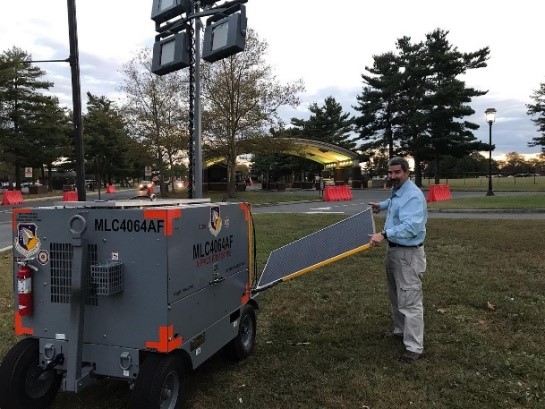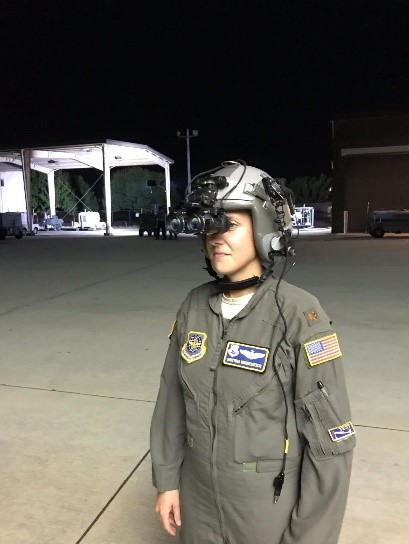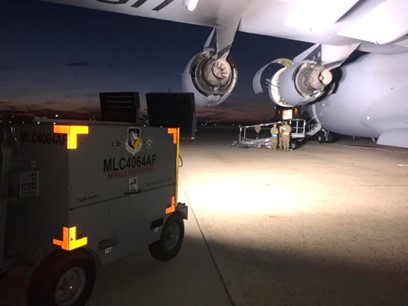WRIGHT-PATTERSON AIR FORCE BASE, Ohio – The U.S. Air Force has an inventory of approximately 5,500 diesel light carts that provide flight line and perimeter illumination. This lighting is a necessity for aircraft maintenance, troubleshooting and perimeter lighting to secure the outskirts of deployed/contingency locations.
Flight line aircraft maintenance performed at night often requires both lighting and supplemental 120 volt power that the light carts provide.
A more energy-efficient hybrid light cart was recently tested under a project titled, Advanced Flight line Power and Light System. The carts were delivered to Joint Base McGuire-Dix-Lakehurst, New Jersey, to gather operator feedback on new technologies and capabilities in September 2020.
AFPALS is an Air Force Research Laboratory-led effort that includes Air Force Materiel Command Logistics and Sustainment-Common Support Equipment Office, Support Equipment and Vehicles Program Office, Air Mobility Command’s Logistics, Engineering and Force Protection Division, Concurrent Technologies Corporation working in conjunction with JB MDL’s Test and Evaluation Squadron, Air Force Civil Engineering Center, and the 305th Maintenance Squadron’s Aerospace Ground Equipment Flight.
The current inventory of light carts are based on a continuously running diesel engine and 1000 watt metal-halide lamps, which can take 10-20 minutes to fully illuminate. The AFPALS prototype is a hybrid light cart that employs a new Army-developed Li-Ion 6T battery, light emitting diode lamps, new sensors, solar cells, advanced controls and health monitoring as well as a re-engineered operating architecture.
The lights and auxiliary power come directly from the battery to enable more efficient, quiet, low-emission operations. The battery also empowers the utilization of renewable energy and enables recharging from the power grid power via common outlets in the hangar.
“The U.S. Air Force-wide team working on this next generation light cart project has been amazing,” said Tom Layne from AFRL’s Advanced Power Technology Office. “Everyone wants to see the flight line modernize with maintenance executed more efficiently and effectively and they are willing to assist. The 305th Maintenance Group, Squadron, Flight and Master Sgt. Bono at JB MDL, were incredibly supportive, helpful and welcoming.”
“The current U.S. Air Force light cart enterprise is healthy, but there are innovative technologies we can embrace to improve the capabilities for our maintainers,” said Chief Master Sgt. Haralson from AFMC Logistics, Civil Engineering, Force Protection and Nuclear Integration Office at Wright-Patterson AFB.
Program office engineers, Jeff Hill and Lauren Janelle from Air Force Life Cycle Management Center’s Support Equipment Program Office, Robins AFB, collected data while at JB MDL. The data indicates that AFPALS could run autonomously for more than three weeks on a single tank of petroleum (32 gallons).
For comparison, the JB MDL team indicated that the legacy unit would probably require over 160 gallons of fuel and over 42 maintainer touches during the same period. This results in a huge cost savings of petroleum, alone.
Chief Master Sgt. Richards from AFMC Logistics, Civil Engineering, Force Protection and Nuclear Integration Office, was thrilled with the results. “Working smarter, expending less energy, reducing manpower tasking and continuously striving to modernize the support equipment enterprise is the ultimate goal. The demos allow requirements to be set for better equipment tomorrow enabling old capability that has been used for the past 30 years to be upgraded. These AFRL programs are needed to assist in moving forward as an enterprise.”
The JB MDL 305th Maintenance Group, Squadron Commanders, Contingency Response Wing and local U.S. Marine Corp gathered to observe AFPALS. “The operators spoke positively on the immediate illumination from the LED lights, quiet/low-emission operations, autonomous operations and reduced fuel usage for their forward operating environments,” said Lt. Hernandez-Rivera from APTO.
Improvements to make flight line aircraft maintenance agile, efficient, quiet, responsive and less hazardous are all wins.
Phase two of AFPALS will experiment with a new innovative wireless control and health monitoring capability to increase autonomous operations to make innovative capabilities possible.
For more statistics about the AFPALS project, or APTO efforts, contact AFRL.RXSC.APTO@us.af.mil, or 937-674-5046.

Jeff Hill, lead engineer from the Air Force Life Cycle Management Center’s Support Equipment Program Office collects data from the hybrid cart and displays solar panels on the Advanced Flightline Power and Light System at gates at Joint Base McGuire-Dix-Lakehurst, New Jersey. (U.S. Air Force photo/Master Sgt. John Bono)

Maj. Kristina Himmelreich, C-17 Globemaster pilot, and Tech. Sgt. Chris Olmsted, crew chief, from the Joint Base McGuire-Dix-Lakehurst, Air Mobility Command Test Evaluation Squadron, supported the project by evaluating Advanced Flightline Power and Light System’s LED impact on aircrew night vision goggles. (U.S. Air Force photo/Master Sgt. John Bono)

